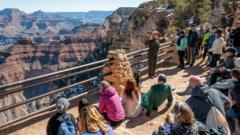As national parks and forests across the United States grapple with significant staffing cuts affecting essential services and visitor safety, a tide of dissent has surfaced from both employees and the public. These drastic measures, instituted under the Trump administration, have led to longer entrance lines, closed trails, and decreased maintenance of facilities that are critical for both environmental health and visitor experience.
**National Parks Face Crisis Amid Staffing Cuts and Public Outcry**

**National Parks Face Crisis Amid Staffing Cuts and Public Outcry**
Massive reductions in personnel at national parks and forests have sparked widespread concerns regarding safety and conservation efforts.
The recent termination of approximately 4,400 employees—5% of the National Park Service and 10% of the Forest Service staff—has rendered management of these natural treasures increasingly challenging. Workers like Kate White, a seasoned wilderness ranger, express deep concerns about the implications for public safety, particularly as the summer months approach. White notes her role often involved both rescuing and ensuring the safety of visitors in precarious conditions, a responsibility compromised by staffing shortages.
In addition to practical safety concerns, the fallout is felt in conservation efforts. Andria Townsend, a biologist previously overseeing endangered species studies at Yosemite, fears for the vulnerable populations she's worked to protect. The picture painted by former employees is one of discontent, highlighting feelings of underappreciation amid accusations of “performance” issues cited in termination notices.
Despite a backlash leading to the rehiring of some staff, the ramifications of these cuts are already evident in the form of inadequate visitor services and potential ecological challenges. Those planning trips to national parks are advised to prepare for a fundamentally altered experience, questioning the sustainability of America's cherished outdoor landscapes without adequate personnel to maintain them.
As federal officials such as Interior Secretary Doug Burgum vow to increase seasonal hires, skepticism remains regarding the long-term impacts of these severe budgetary policies. Outdoor advocacy groups warn that unless these measures are reversed, both the preservation of the environment and the quality of visitors' experiences may face dire consequences.
The situation poses critical questions about the future of national parks and forests, their ability to offer safe and well-maintained spaces for public enjoyment, and the broader implications for wildlife conservation during an increasingly fragile time.
In addition to practical safety concerns, the fallout is felt in conservation efforts. Andria Townsend, a biologist previously overseeing endangered species studies at Yosemite, fears for the vulnerable populations she's worked to protect. The picture painted by former employees is one of discontent, highlighting feelings of underappreciation amid accusations of “performance” issues cited in termination notices.
Despite a backlash leading to the rehiring of some staff, the ramifications of these cuts are already evident in the form of inadequate visitor services and potential ecological challenges. Those planning trips to national parks are advised to prepare for a fundamentally altered experience, questioning the sustainability of America's cherished outdoor landscapes without adequate personnel to maintain them.
As federal officials such as Interior Secretary Doug Burgum vow to increase seasonal hires, skepticism remains regarding the long-term impacts of these severe budgetary policies. Outdoor advocacy groups warn that unless these measures are reversed, both the preservation of the environment and the quality of visitors' experiences may face dire consequences.
The situation poses critical questions about the future of national parks and forests, their ability to offer safe and well-maintained spaces for public enjoyment, and the broader implications for wildlife conservation during an increasingly fragile time.





















